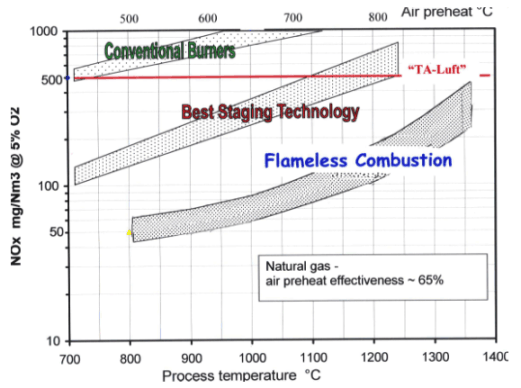-
What is the effect of flameless operation upon NOx formation?
Date posted:
-
-
Post Author
espadmin
1. Background to NOx formation in flames
The high temperature zones of the flame are the principal sources of NOx, mainly consisting of NO formed by following mechanisms:
- [GLOSS]Thermal NO[/GLOSS] formation (CF40): the formation rate of thermal NO is very much enhanced by the existence within a flame of oxygen rich pockets at high temperature.
- [GLOSS]Prompt NOx[/GLOSS] route (
- CF42): this mechanism is enhanced in the presence of radicals in the flame front.
- Fuel NOx (
- CF41): when burning oil, and in particular coal, fuel nitrogen provides a further source of NOx.
- N2O route: in some circumstances, a NOx producing mechanism via formation of N2O is also active.
2. How does flameless operation reduces NOx formation?
When a furnace is operated in the [GLOSS]Flameless combustion[/GLOSS] mode (CF171), there is no flame front and no visible flame. Because of the large quantities of recirculated combustion products entrained into the fresh reactants before combustion, the maximum temperature after reaction is consistently limited with respect to the [GLOSS]Adiabatic flame temperature[/GLOSS] of the pure reactants. Consequently, mean temperatures in the reaction zone are everywhere close to the temperature of reaction products, i.e. of the furnace or process temperature. Turbulent fluctuations of temperature and oxygen concentration are inherently limited and free radical formation is also hampered.
For these reasons, flameless operation effectively abates the thermal and prompt routes to NOx formation in combustion systems (most of which operate with a mean gas temperature below that causing significant rates of thermal NO formation).
3. How much NOx is formed in the flameless combustion?
NOx produced from flameless operation of natural gas burners is shown in Figure 1 for a range of furnace /flue gas temperatures and corresponding high air preheat temperatures (assuming a preheating effectiveness x of ~ 65% – see CF172)
In Figure 1, flameless NOx levels are also compared with:
- Emissions from traditional gas burners
- NOx produced by conventional flames deploying [GLOSS]Staged combustion[/GLOSS] systems
- NOx limit set by the German “TA Luft” regulation for furnaces at 500 mg/Nm3.
Large reductions in NOx formation are achieved. NOx can be held well below TA Luft regulations even when using high air preheats.
Figure 1 is valid for most high calorific value fuel gases and depends only slightly on the burner design. Given:
- The width of the band shown for flameless combustion
- The logarithmic scale of the NOx axis,
Figure 1 should be used to obtain a general guidance to the NOx levels that may result from a switch to flameless operation, which is possible for process temperature above ~ 800°C only.

Figure 1 ¨C NOx emissions vs furnace temperature with high air preheat
Sources
[1] J.A.Wunning, J.G. Wunning, Flameless Oxidation to reduce thermal NO formation – Progr. Energy Combust. Science, 23, #12, 81-94, 1997
